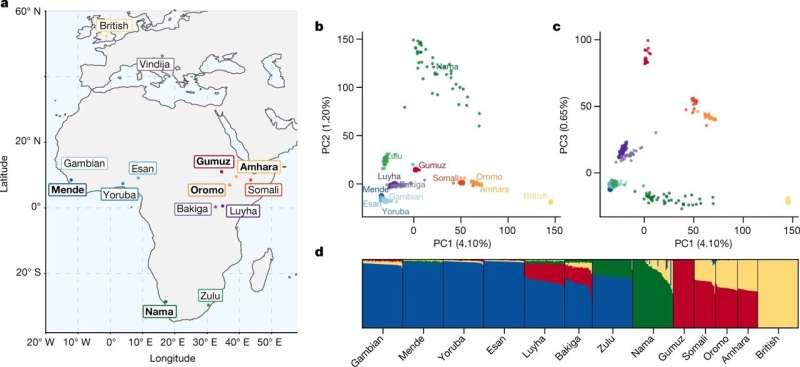McGill University
Source - https://phys.org/news/2023-05-human-africa.html
 a, Selected populations from the 1000 Genomes Project and the African Diversity Reference Panel illustrate diversity from western, eastern and southern Africa. We chose representative ethnic groups from each region (bold labels) to build parameterized models, including the newly genetically sequenced Nama populations from South Africa, Mende from Sierra Leone, Gumuz, Oromo and Amhara from Ethiopia, British individuals and a Neanderthal from Vindija Cave, Croatia. b,c, Principal component analysis highlights the range of genetic divergence anchored by western African, Nama, Gumuz and British individuals between principal components (PC) 1 and 2 (b), and 1 and 3 (c). Percentages show variance explained by each principal component. Colours represent the groups shown in bold in a. d, ADMIXTURE analysis using K = 4 principal components reveals signatures of recent gene flow in Africa that reflect colonial-period migration into the Nama, back-to-Africa gene flow among some Ethiopians, and Khoe-San admixture in the Zulu population. Credit: Nature (2023). DOI: 10.1038/s41586-023-06055-y
a, Selected populations from the 1000 Genomes Project and the African Diversity Reference Panel illustrate diversity from western, eastern and southern Africa. We chose representative ethnic groups from each region (bold labels) to build parameterized models, including the newly genetically sequenced Nama populations from South Africa, Mende from Sierra Leone, Gumuz, Oromo and Amhara from Ethiopia, British individuals and a Neanderthal from Vindija Cave, Croatia. b,c, Principal component analysis highlights the range of genetic divergence anchored by western African, Nama, Gumuz and British individuals between principal components (PC) 1 and 2 (b), and 1 and 3 (c). Percentages show variance explained by each principal component. Colours represent the groups shown in bold in a. d, ADMIXTURE analysis using K = 4 principal components reveals signatures of recent gene flow in Africa that reflect colonial-period migration into the Nama, back-to-Africa gene flow among some Ethiopians, and Khoe-San admixture in the Zulu population. Credit: Nature (2023). DOI: 10.1038/s41586-023-06055-y
There is broad agreement that Homo sapiens originated in Africa. But there remain many uncertainties and competing theories about where, when, and how.
In a paper published today in Nature, an international research team led by McGill University and the University of California-Davis suggest that, based on contemporary genomic evidence from across the continent, there were humans living in different regions of Africa, migrating from one region to another and mixing with one another over a period of hundreds of thousands of years. This view runs counter to some of the dominant theories about human origins in Africa.
Competing theories about human origins in Africa
One theory holds that, about 150,000 years ago, there was a single central ancestral population in Africa from which other populations diverged. Another suggests that this central ancestral population was the result of the mixing of modern humans with a Neanderthal-like hominins (human-like beings), resulting in a leap forward in human evolution, as has been suggested took place in Eurasia.
"At different times, people who embraced the classic model of a single origin for Homo sapiens suggested that humans first emerged in either East or Southern Africa," says Brenna Henn, a population geneticist in the Department of Anthropology and in the Genome Center at the University of California, Davis and co-lead author of the research.
"But it has been difficult to reconcile these theories with the limited fossil and archaeological records of human occupation from sites as far afield as Morocco, Ethiopia, and South Africa which show that Homo sapiens were to be found living across the continent as far back as at least 300,000 years ago."
So, the research team took a different approach.
Contemporary genomic evidence tells a different story
In the first systematic test of these competing anthropological models against genetic data, the team worked backwards from contemporary genomic material of 290 individuals from four geographically and genetically diverse African groups to trace the similarities and differences between the populations over the past million years and gain insight into the genetic interconnections and human evolution across the continent.
The groups were the Nama (Khoe-San from South Africa); the Mende (from Sierra Leone); the Gumuz (recent descendants of a hunter-gatherer group from Ethiopia); and the Amhara and Oromo (agriculturalists from eastern Africa). The researchers also included some Eurasian genetic material to include the traces of colonial incursions and mixing Africa.
"We used a new algorithm to rapidly test hundreds of possible scenarios. Those with gene flow back and forth between populations in various parts of the continent over the course of hundreds of thousands of years provided a much better explanation of the genetic variation we see today," adds Simon Gravel, Associate Professor in the Department of Human Genetics at McGill University, and co-senior author on the paper.
"We wrote this algorithm to understand how genetic disease risk varies across populations, and it led us to this deep dive into human origins. It's been really fun to tie applied and fundamental research together in this way."
Brenna Henn, A weakly structured stem for human origins in Africa, Nature (2023). DOI: 10.1038/s41586-023-06055-y. www.nature.com/articles/s41586-023-06055-y